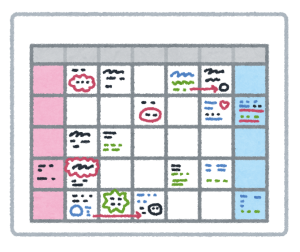Japanese Level 1, Activity #10: “Schedules” / “スケジュール?” (Face-to-Face)
 Image via: irasutoya
Image via: irasutoya
The students will review the verbs they have learned so far, as well as the days of the week, the time of day, and the hours of the day. Then, they will ask and answer questions in pairs about simple daily schedules. Finally, as a group, they will describe what they do on the weekends.
Verbs, times, schedule, activities, pair-work, 動詞, 時間, スケジュール, 活動, ペアワーク, Xがあります/います, Describing Where Things Are, 物がどこにあるかを説明する, Past Tense of です, ですの過去形, Past Tense of Verbs, 動詞の過去形, も, 一時間, たくさん, と
Products: Schedule vocabulary, activities
Practices: Typical Japanese schedules
Perspectives: Japanese Daily Rituals
NCSSFL-ATFL World Readiness Standards:
- Standard 1.1: Students engage in conversation, provide and obtain information, express feelings and emotions, and exchange opinions.
- Standard 1.3: Students present information, concepts, and ideas to an audience of listeners or readers on a variety of topics.
- Standard 4.1: Students demonstrate an understanding of the nature of language through comparisons of the Japanese language and their own.
Idaho Content Standards for World Languages:
- COMM 1.1 – Interact and negotiate meaning (spoken, signed, written conversation) to share information, reactions, feelings, and opinions.
- COMM 2.1 – Understand, interpret, and analyze what is heard, read, or viewed on a variety of topics.
NCSSFL-ACTFL Can-Do Statements:
- I can ask my classmates about their daily schedule.
- I can discuss time by accurately describing the day of the week, the time of day, and specific hours of the day.
- I can present my schedule to my peers.
Materials Needed
Warm-Up:
Pull up the presentation and greet your students in Japanese.
プレゼンテーションを開き、生徒たちに日本語で挨拶します。
Move to the next slide with the “Can-Do Statements” and read each Can-Do statement in English.
次の「Can-Do ステートメント」のスライドに進み、それぞれの Can-Do ステートメントを英語で読みます。
Review
復習
Move to the next slide that shows a time of day, two times, and two activities. Model the activity by checking with the students about the time of day and what the character is doing. For example, for the first slide you would point to the picture and say:
- 今日は月曜日です。いつですか。
次のスライドに移動すると、時刻、時刻、アクティビティが 2 つ表示されます。 時間帯とキャラクターが何をしているかを生徒たちと確認して、アクティビティをモデル化します。 たとえば、最初のスライドでは、写真を指して次のように言います:
- 今日は月曜日です。いつですか。
Students reply: 朝です!
- 朝ですね。何をしますか?
Students reply: 起きます!
- はい、そうです。朝、起きます。
- 何時に起きますか?
Students reply: 8時!
はい、そうです!じゃ、「8時に起きます。」リピートしてください!
Students reply: 8時に起きます!
For the second action listed on the slide, repeat the same process.
スライドにリストされている2番目のアクションについて、同じプロセスを繰り返します。
For the next two slides (afternoon and evening) ask the students questions and try to have them guess the sentence before you tell them.
次の2つのスライド(午後と夕方)では、生徒に質問し、伝える前に文章を推測してもらいます。
Note: Each slide has a day of the week. When introducing each slide, the lab instructor will say what day it is, but the students will not be expected to create a sentence including it.
注:各スライドには曜日があります。各スライドを紹介するとき、ラボのインストラクターは今日が何日かを言いますが、学生はそれを含む文章を作成することは期待されません。
Main Activity:
Asking about schedules
スケジュールについて尋ねる
Show the students the next slide with more activities and specific times. Again, the lab instructor will introduce the day of the week, but students will not be expected to use it.
より多くの活動と特定の時間で次のスライドを学生に見せてください。繰り返しになりますが、ラボのインストラクターが曜日を紹介しますが、学生はそれを使用することを期待されません。
Have the students pair up.
- ペアになって下さい。
Have the students ask each other questions for each time and activity on the slide. For example:
- 10時、学校に行きますか? 本を読みますか? テレビを見ますか?
- 1時、学校に行きますか? 本を読みますか? テレビを見ますか?
Each pair of students should continue and ask each other questions for each time and activity.
学生の各ペアは継続し、時間と活動ごとにお互いに質問する必要があります。
Once the students have discussed every question in pairs, have them come back together as a group to share.
生徒がペアですべての質問について話し合ったら、グループとして一緒に戻って共有します。
They should share one answer about their schedule. For example:
- 10時に学校に行きます
- 1時に本を読みます
- 3時に本を読みます
- 9時にテレビを見ます
Have the students repeat this for the next two slides.
次の2つのスライドについて、生徒にこれを繰り返してもらいます。
Make sure the students change partners for each slide.
生徒がスライドごとにパートナーを変更するようにしてください。
Wrap-Up:
Come back together as a group to discuss the weekend!
週末にグループで集まって話し合ってください。
Explain that the weekend is made up of Saturday and Sunday.
- 週末は土曜日と日曜日です。
Ask the students what they do on the weekend.
- 週末は、何をしますか?
Ask if there are any final questions!
- 何か質問がありますか?
End of activity:
- Read Can-Do statements once more and have students evaluate
their confidence. - (Use thumbs up/thumbs down or download our student cards.)
- Encourage students to be honest in their self-evaluation.
- Pay attention, and try to use feedback for future activities!
NCSSFL-ACTFL Can-Do Statements:
- I can ask my classmates about their daily schedule.
- I can discuss time by accurately describing the day of the week, the time of day, and specific hours of the day.
- I can present my schedule to my peers.

